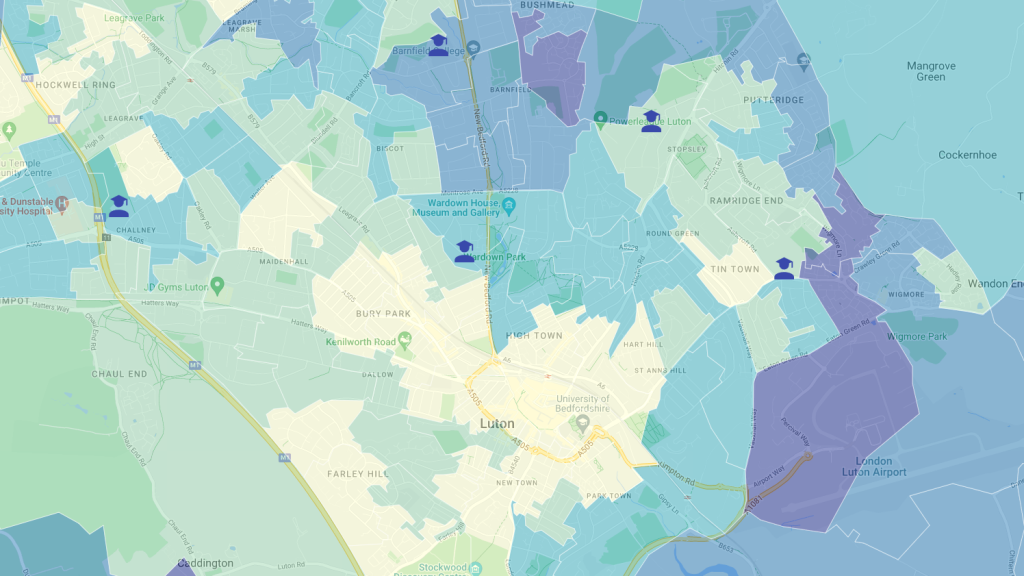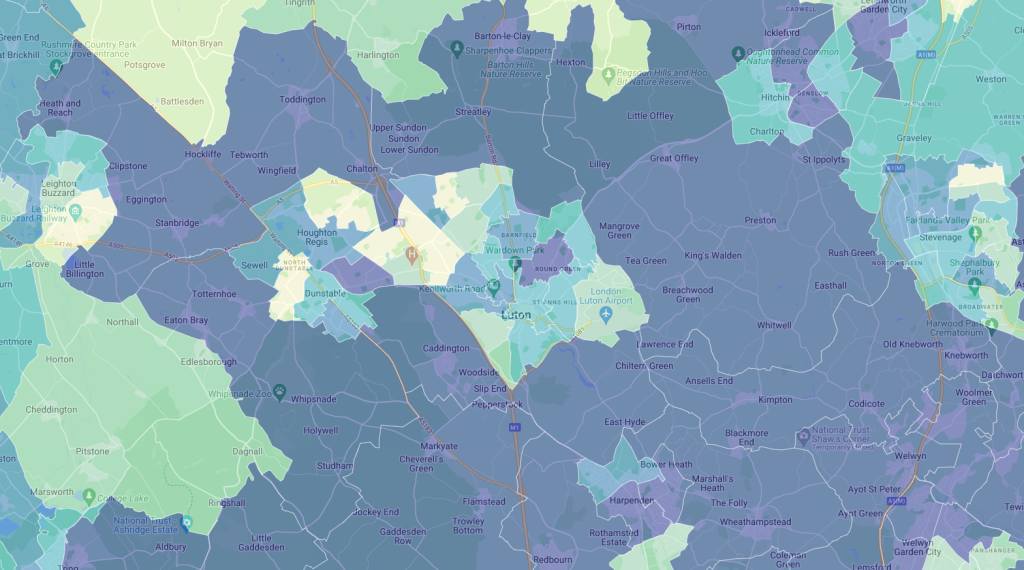
Luton Borough is a very diverse town, with a population of around 225,000 people. Luton has real disparities in terms of deprivation. While being situated about 30 miles north of London, it shares many more characteristics with some London boroughs than it does adjacent authorities. The council has a central business intelligence team – the Information Intelligence Unit, which provides data and insight support to the whole council. Luton’s town wide strategy, Luton 2040 has a bold and ambitious vision – a healthy, fair, and sustainable town where everyone can thrive, and no one has to live in poverty.
In order to achieve this, the Information Intelligence Unit needs to be well informed of the needs of residents. The team uses Local Insight in their day-to-day operations to support their colleagues and partners to work in an evidence-led way through responding quickly to ever changing needs. Alamin Mukith leads the team and shared with us some of the ways Local Insight provides them with value.
A public health manager within the council reached out to the Information Intelligence Unit for some support on an anti-smoking campaign. They wanted a strategic and systematic way of approaching schools for outreach work. Research suggests that children in more deprived areas are more likely to take up smoking. With Local Insight, they were able to pull up a map of the Index of Multiple Deprivation and overlay this with point-location information on where the schools are. From here, they were able to quickly and easily identify which schools were located in the most deprived areas and approach these schools first. Alamin noted “that would have taken weeks in the past – but now we have the evidence base at hand and we can be more efficient and more impactful.”

The IMD rank of Luton LSOAs, with secondary school locations overlaid.
In May 2023 ward boundaries changed in Luton – increasing from 19 to 20. Local Insight enabled the team to start using data for these new boundaries instantly, all they needed to do was create a custom area – and all the data was instantly aggregated. Alamin says “without Local Insight, it would have been a lot of work – a lot of Excel processing and a lot of it would have been guess work.”
As Local Insight includes a vast number of public datasets in one place – it took the time and effort out of building new reports for these areas. This meant that the Information Intelligence Unit could provide information to councillors and other stakeholders about their patch quickly – “ward profiles were a real priority for me. More than anything residents should know what is happening in their area – how many people live there and what the challenges are. It makes it more transparent and the councillors more accountable. We need people to be empowered by data so a delay on the ward reports would have been a bad thing.”
Local insight frees up time for analysis through doing all the collecting, cleaning and processing of public data sets. For Alamin, this provided real value when Census 2021 data was released. The data was added into Local Insight quickly, with useful breakdowns and instantly aggregated to all of Luton’s key neighbourhoods. “There was a lot of pressure on Luton as census data was being released, as there had been some questions about the accuracy of the previous year’s mid-year estimates, so we were under pressure to get summaries out to people really quickly. Local Insight helped with that and we were able to sit back and focus on the analysis.”
Luton has been using Local Insight to gain a deeper understanding of its community’s needs and to better develop services that meet those needs.
One example of this is the Community Hubs initiative, which looks at how places that provide multi-agency services can also be used as a location for people to socialise, and work as a community hub. The team used Local Insight to do a lot of the initial analysis to understand the needs and challenges in different parts of the town. They identified needs at ward level, through producing data tables on a range of “place indicators”, covering topics such as crime, education and health. Through ranking these results relative to each other, they were able to identify the worst performing areas for each ward. This analysis could then be used to ensure any future services at potential community hubs (for example, warm spaces) correspond to local needs.
They also explored the Community Needs Index, which was developed by OCSI, in detail and what that meant for Luton and found it was helpful in gaining perspective – “the data showed Luton was fairly rich in community assets compared to our more affluent neighbourhoods. It was helpful to understand that there are areas that have high scores on the Index of Multiple Deprivation and other areas with high scores on the Community Index, but actually there aren’t any areas that score in the top ten percent for both.”

The Community Needs rank of Luton and its surrounding areas, displayed at MSOA level.
Luton also has a public version of Local Insight – allowing any stakeholders to interact with the data, areas and reports. Part of the Information Intelligence Unit’s remit is to build up team’s across the council in terms of their confidence with using data. A training session on Local Insight is now offered as part of their corporate learning and development programme. Alamin says “we have people coming from all over the place and they love it! They are so impressed when I show them how easy it is to explore data on the maps and overlay services – and they are excited that they can do it for themselves.”
To find out more about how Local Insight can support your organisation, book a demo now.
We have added a new indicator that measures childcare accessibility in England…
More
In the latest round of updates made to Local Insight, we’ve introduced…
More
We’ve introduced a new feature to Local Insight – a Share button…
More